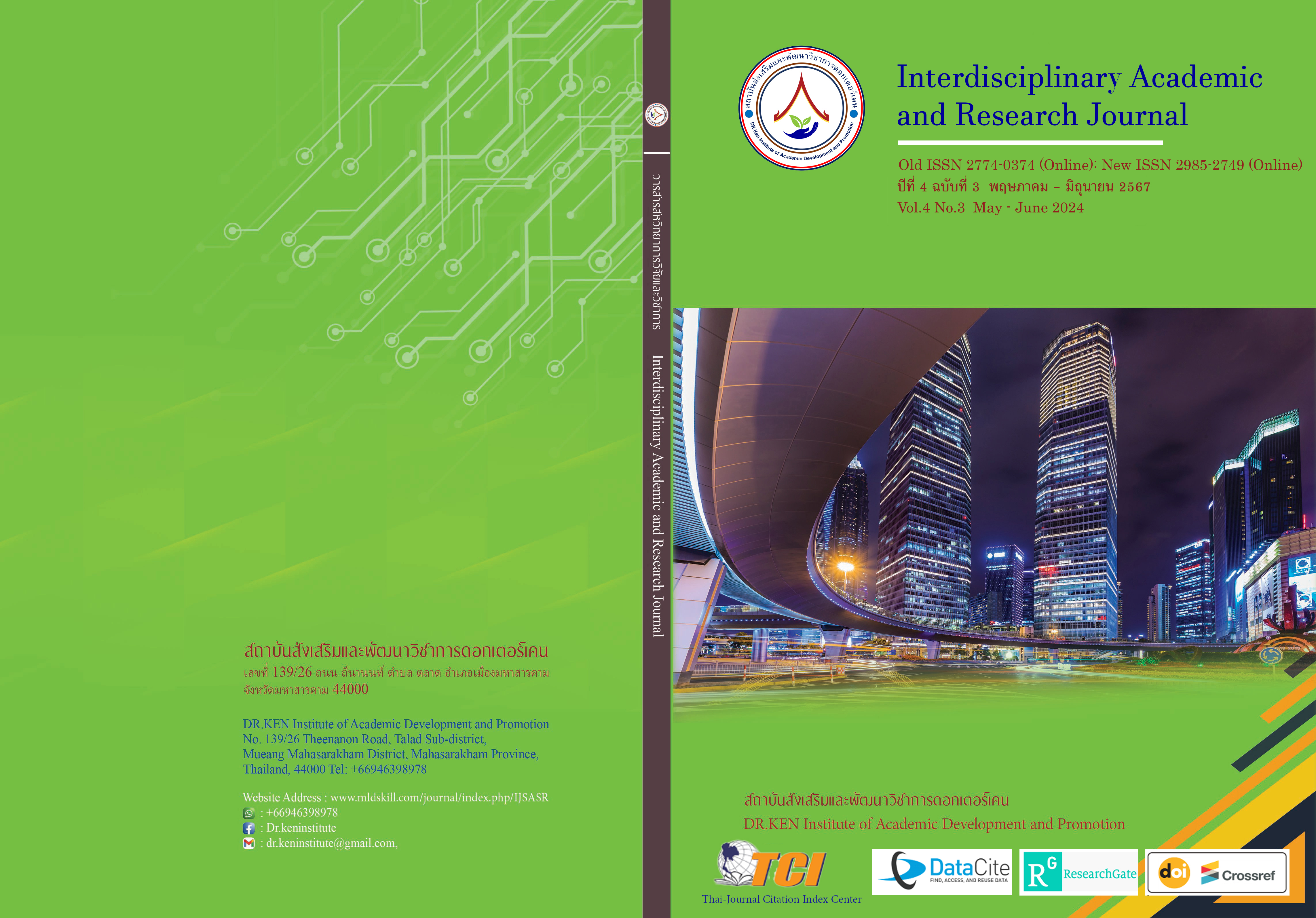The Development of Chemistry Instructional Model to Enhance Creative Problem-Solving Skill of Matthayomsuksa 5 Students, Thesaban 2 School, Thesaban Nangrong, Buriram Province
DOI:
https://doi.org/10.60027/iarj.2024.275554Keywords:
Chemistry Instructional Model; , Creative Problem-solving SkillsAbstract
Background and Aims: Chemistry science education in Thailand is a field that not only modernizes the curriculum and content but also strives to improve the quality of teaching.
In teaching and learning, emphasis must be given to students having knowledge and understanding of scientific concepts and being able to apply that knowledge so that students can develop advanced thinking. This research aims to (1) develop a teaching model for teaching chemistry on acids and bases that promotes the creative problem-solving skills of Mathayom 5 students. (2) study the results of using a chemistry teaching model on acids and bases that promotes creative problem-solving skills of Mathayom 5 students.
Methodology: The sample group that tested the model was 31 Mathayom 5/1 students at Thesaban 2 School, Nang Rong Municipality, Buriram Province, Semester 2, academic year 2022. The instrument used to collect data includes a chemistry teaching model on acids and bases that promotes the creative problem-solving skills of Mathayom 5 students. Academic achievement test, creative problem-solving test, and learning satisfaction measure. Statistics used in data analysis include mean, percentage, standard deviation, and t-test (Dependent) statistics.
Results: The finding revealed that the instructional model consisted of 6 components principles and basic concepts, The teaching process has 6 steps: (1) creating interest (E: Engagement) (2) discussion (D: Discussion) (3) practice (P: Practice) (4) reflecting thoughts (R: Reflection Thinking) (5) Categorize content (O: Organization) (6) Test abilities (T: Talent test) The appropriateness of instructional model was the highest level. A student could develop learning achievement was significantly higher than the pretest at the significant level of .05, the creative problem-solving skill was significantly higher than 70 percent, and the satisfaction learning on mathematics instructional model to enhance creative problem-solving skill was the highest level.
Conclusion: The instructional model, which consists of six components and phases, was shown to have high appropriateness and considerably enhanced learning outcomes, creative problem-solving abilities, and mathematical satisfaction levels. This highlights how well it supports students' holistic learning and skill development.
References
กัญญารัตน์ โคจร และคณะ. (2554). การพัฒนารูปแบบการเรียนรู้การคิดแก้ปัญหาอย่างสร้างสรรค์ เรื่อง สารและสมบัติของสารสำหรับนักเรียนชั้นมัธยมศึกษาปีที่ 1. วารสารวิจัย มหาวิทยาลัยขอนแก่น. 1(2), 1-20.
ทิศนา แขมมณี. (2558). ศาสตร์การสอน: องค์ความรูเพื่อการจัดกระบวนการเรียนรูที่มีประสิทธิภาพ. พิมพ์ครั้งที่ 19. กรุงเทพฯ: ด่านสุทธาการพิมพ์,.
ธนศักดิ์ เจริญธรรม. (2565). การพัฒนารูปแบบการจัดการเรียนรู้วิชาเคมี เพื่อพัฒนาผลสัมฤทธิ์ทางการเรียนและการคิดอย่างมีวิจารณญาณ ของนักเรียนชั้นมัธยมศึกษาปีที่ 4. วารสารศึกษาศาสตร์ มหาวิทยาลัยมหาสารคาม, 16(3): กรกฎาคม – กันยายน.
วิชาการโรงเรียนเทศบาล 2 เทศบาลเมืองนางรอง. (2561). รายงานการประเมินตนเอง (SAR). โรงเรียนเทศบาล 2 เทศบาลเมืองนางรอง.
วีณา ประชากูล และประสาท เนืองเฉลิม. (2559). รูปแบบการเรียนการสอน. พิมพ์ครั้งที่ 3. มหาสารคาม: มหาวิทยาลัยมหาสารคาม.
ศรีผกา เจริญยศ มาเรียม นิลพันธุ์ และมารุต พัฒผล. (2563). การพัฒนารูปแบบการจัดการเรียนรู้ตามแนว Active Learning เพื่อเสริมสร้างมโนทัศน์การเรียนรู้เคมีแลทักษะ การคิดอย่างมีวิจารณญาณ ของนักเรียนชั้นมัธยม ศึกษาตอนปลาย. วารสารสุทธิปริทัศน์. 34 (109), 46-57.
สถาบันส่งเสริมการสอนวิทยาศาสตร์และเทคโนโลยี. (2555). ครูคณิตศาสตร์มืออาชีพเส้นทางสู่ความสำเร็จ. กรุงเทพฯ: 3–คิวมีเดีย.
อมรัชญา ชินศร. (2558). การพัฒนารูปแบบการจัดการเรียนรู้วิทยาศาสตร์เพื่อส่งเสริมความสามารถในการแก้ปัญหาของนักเรียนชั้นมัธยมศึกษาปีที่ 2. วิทยานิพนธ์ปรัชญาดุษฎีบัณฑิต หลักสูตรและการสอน มหาวิทยาลัยราชภัฎวไลยอลงกรณ์ในพระบรมราชูปถัมภ์.
Darling-Hammond, L., Wei, R.C., Andree, A., Richardson, N., & Orphanos, S. (2009). Professional learning in the learning profession: A status report on teacher development in the United States and abroad. National Staff Development Council.
Gallagher, S.A., & Stepien, W.J. (1996). Content acquisition in problem-based learning: Depth versus breadth in American studies. Journal for the Education of the Gifted, 19(3), 257-275.
Guskey, T. R., & Yoon, K. S. (2009). What works in professional development? Phi Delta Kappan, 90(7), 495-500.
Hamari, J., Koivisto, J., & Sarsa, H. (2014). Does gamification work? -- A literature review of empirical studies on gamification. In 2014 47th Hawaii International Conference on System Sciences (pp. 3025-3034). IEEE.
Hmelo-Silver, C.E., Duncan, R.G., & Chinn, C.A. (2007). Scaffolding and achievement in problem-based and inquiry learning: A response to Kirschner, Sweller, and Clark (2006). Educational Psychologist, 42(2), 99-107.
Jonassen, D.H., & Hung, W. (2008). All problems are not equal: Implications for problem-based learning. Interdisciplinary Journal of Problem-Based Learning, 2(2), 6.
Joyce, B.R., Weil, M., & Calhoun, E. (2011). Models of Teaching. Boston: Pearson/Allyn and Bacon Publishers.
Lopes, C., Vaz-de-Melo, P., & Rosa, A. (2019). The role of active learning methodologies on students' motivation. In Proceedings of the European Conference on Games Based Learning (Vol. 3, p. 382). Academic Conferences International Limited.
Merrill, M.D. (2002). First principles of instruction. Educational Technology Research and Development, 50(3), 43-59.
Mitchell, W.E., & Konalik, T.F. (1999). Creative Problem Solving. n.p.: Unpublished.
Nguyen, Q., Rivas, R., Kar, P., Luong, A., Li, Y., & Hwang, D. (2020). Adaptive learning systems: A review and conceptual framework for modeling and evaluation. IEEE Access, 8, 22191-22212.
Schunk, D.H., & Mullen, C.A. (2012). Self-efficacy as an engaged learner. In Handbook of research on student engagement (pp. 219-235). Springer.
Slavin, R.E. (1990). Cooperative Learning: Theory, Research and Practice. New Jersey: Prentice-Hall.
Treffinger, D.J., Isaksen, S.G., & Dorvol, K.B. (2005). Creative Problem Solving (CPS Version 6.1TM) A Contemporary Framework for Managing Change. Sarasota: Center for Creative Learning and Creative Problem-Solving Group.
Downloads
Published
How to Cite
Issue
Section
License
Copyright (c) 2024 Interdisciplinary Academic and Research Journal

This work is licensed under a Creative Commons Attribution-NonCommercial-NoDerivatives 4.0 International License.
Copyright on any article in the Interdisciplinary Academic and Research Journal is retained by the author(s) under the under the Creative Commons Attribution-NonCommercial-NoDerivatives 4.0 International License. Permission to use text, content, images, etc. of publication. Any user to read, download, copy, distribute, print, search, or link to the full texts of articles, crawl them for indexing, pass them as data to software, or use them for any other lawful purpose. But do not use it for commercial use or with the intent to benefit any business.
















.png)


